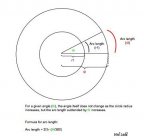Hello all, I am trying to understand how bullet drops work. Below is the range and elevation of my 300 Win Mag. Can someone explain to me why I only have to dial 1.8 clicks at 450 yards and that compensates for 29 inches of bullet drop (28.85 to be exact)? I'm using a 200 yard zero. Full ballistic table is here.
| Range | Elevation MRAD |
| Yards | MIL |
| 50 | - .2 |
| 100 | - .4 |
| 150 | - .2 |
| 200 | 0 |
| 250 | .3 |
| 300 | .6 |
| 350 | 1 |
| 400 | 1.4 |
| 450 | 1.8 |
| 500 | 2.2 |
| 550 | 2.7 |
| 600 | 3.2 |











